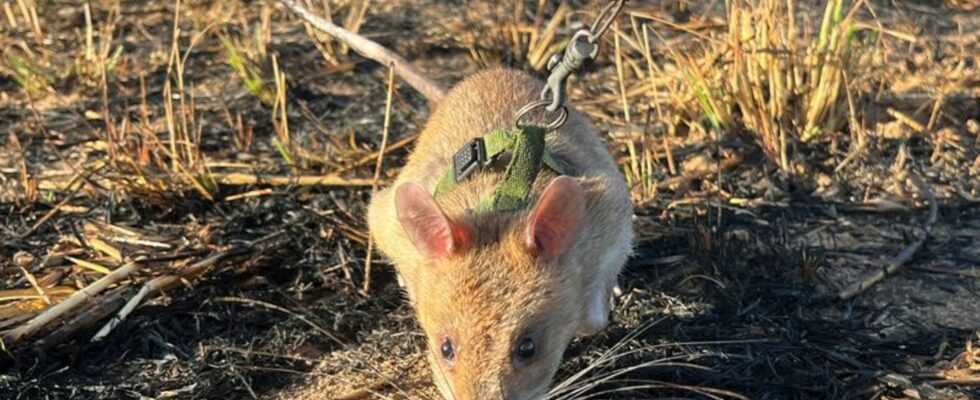Angola is one of the countries with the most landmines in the world. Defusing them is a laborious process. There are new victims every month. Now rats are speeding up the clearance process.
Baraka scurries eagerly across a stubble field. He can’t see very well, but his sense of smell is extremely well developed. Baraka, a giant hamster rat, has an important job: he has to find buried explosives.
While working, the rodent is strapped into a small harness that is connected to a long line via a wire. At each end of the line stands an animal handler dressed in mine protection gear, as Baraka is walking across an area where there may be buried landmines.
The rat has already found something. It stops, sniffs intensively, scratches the earth a little. That is the sign that Baraka has discovered a mine, explains Raul Ilidio, the rat’s human work partner. Numbered signs are put up at the edge of the field to mark the position of the explosives. Now human demining experts know exactly where to defuse the mine.
Baraka is one of twelve giant bagger rats that are currently helping the Belgian organization Apopo in Angola’s Kwanza Sul province to clear landmines that were laid during the 27-year civil war (1975 – 2002). They are called “hero rats” because the rodents are literally saving lives in post-war Angola, one of the countries with the most landmine victims per year in the world. Since the civil war, more than 88,000 landmine injuries have been reported in the southern African country of 36 million inhabitants. According to the international “Landmine Monitor”, the actual number is probably much higher.
No month without new victims
The world first became aware of the emergency in Angola in the late 1990s, when the British Princess Lady Diana visited the civil war-torn country and walked through a minefield wearing protective clothing. The images went around the world and sparked a global debate. But for Angola, the attention came too late.
Once the mines are buried, clearing them is difficult, time-consuming and extremely dangerous. Twenty-two years after the end of the civil war, according to the latest “Landmine Monitor” report, almost 70 square kilometers still need to be cleared in Angola. On average, the country has made about six square kilometers of progress per year. This poses great risks for the population: in 2022, 107 people in Angola were killed or injured by landmines. “Not a month goes by without new victims,” says Manuel Agostinho, Apopo’s project manager in Angola.
However, Apopo is making good progress with the giant hamster rats as explosives sniffers. The rodents work much more effectively than humans. While a mine expert with a metal detector needs two days to clear 200 square meters and works at the risk of his life, a rat can do the same job in half an hour, explains Agostinho. The rats are not only fast, they are also too light to trigger an anti-personnel mine, weighing a maximum of two kilograms, says Shaibu Hamisi, Apopo’s rat training expert. Even a sniffer dog would not be light enough.
Every rat that is deployed in minefields must undergo rigorous training. The rodents are initially trained for six to eight months and then tested at regular intervals. “The rats’ job is not one where mistakes can be made,” says Hamisi. Accuracy is even more important than speed. Because mistakes can cost lives.
Fear is part of everyday life
Thanks to the rats, more and more people in Angola can once again work their fields or look for firewood in the forest without worry. Children can roam around in the open air. The inhabitants of the village of Calulo in Kwanza Sul, around which Apopo is currently clearing mined fields, are also hoping for this level of safety. Because every child in the village knows about the dangers that still lie hidden underground. And almost everyone knows a family that has been affected by an accident.
However, for Ana José Capagaio, a single mother of seven children, the hero rats came too late. Three years ago, the 37-year-old lost her left leg. She was looking for firewood just 150 meters from her house when she stepped on a landmine, she says. The small farmer, who had previously fed her family with what she could plant and harvest, is happy to have survived. But since the accident, Capagaio and her children have had to rely on handouts. Her brother, Joao Capagaio, says the villagers knew about the landmines, but not that there were so many. He is now monitoring the rats’ progress and hopes that his children will be able to grow up without the lurking danger of landmines in the future.
Millions of landmines worldwide
Apopos hero rats are not only used in Angola. The explosives sniffers also help with clearance work in other countries contaminated by landmines – Cambodia, Vietnam, Thailand, Laos and Zimbabwe. Agostinho hopes that their quick work will help to make faster progress in mine clearance. However, Angola will not be able to meet its goal of having all mines defused by the end of 2025.
According to the United Nations Mine Action Service (UNMAS), there are still around 110 million landmines buried in 70 countries worldwide. If they were lined up one meter apart, they would circle the earth almost three times. Afghanistan, Bosnia-Herzegovina, Cambodia, Croatia, Ethiopia and Turkey are among the countries with the most extensive mine contamination per square kilometer. According to the UN, up to 2,000 people are killed or injured by landmines every month worldwide. Most of the victims are civilians, half of them children. According to UNMAS, an anti-personnel landmine can be produced for less than 1 euro – but it costs between 300 and 1,000 euros to defuse it. And above all, it takes a lot of time.

